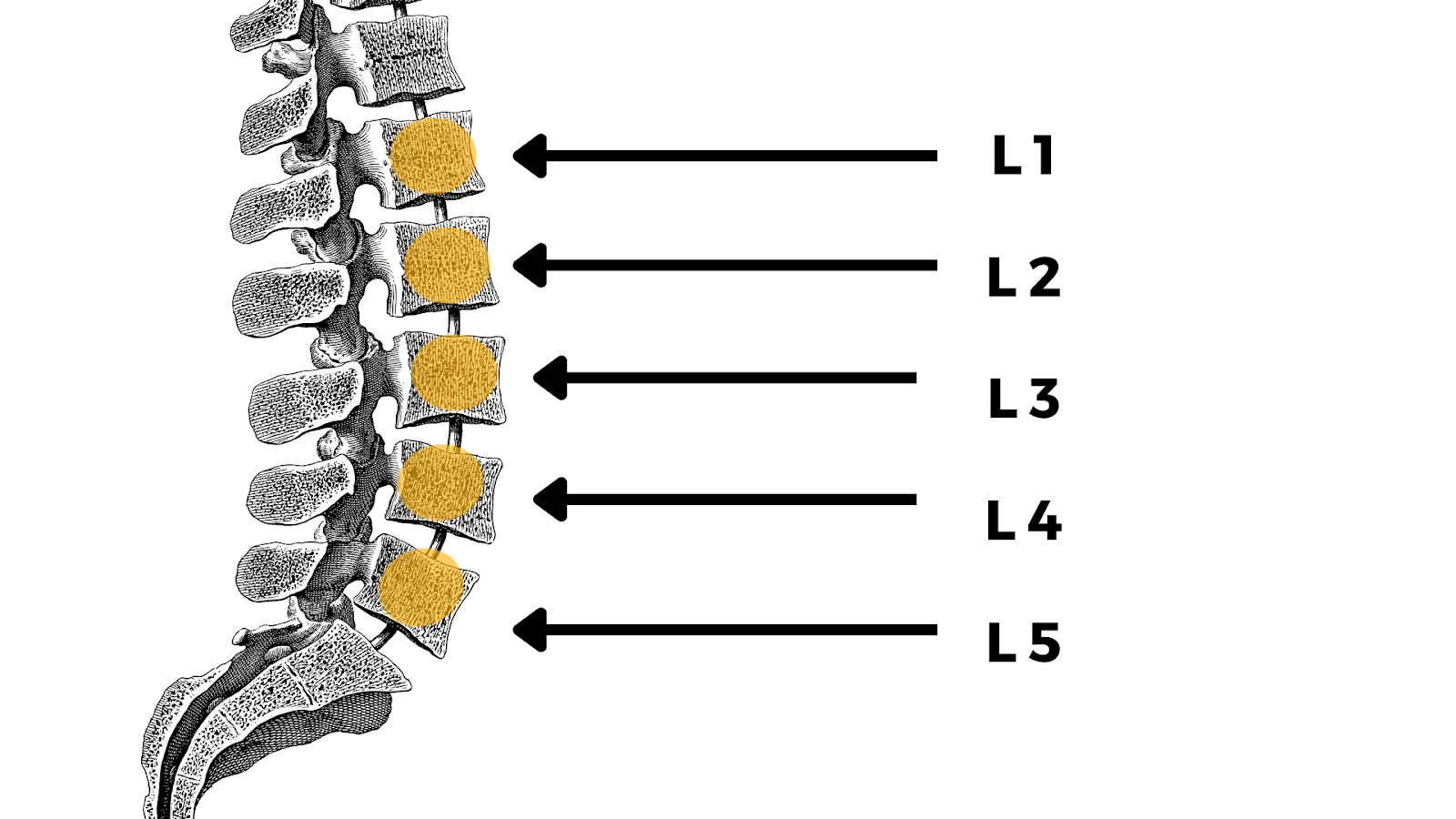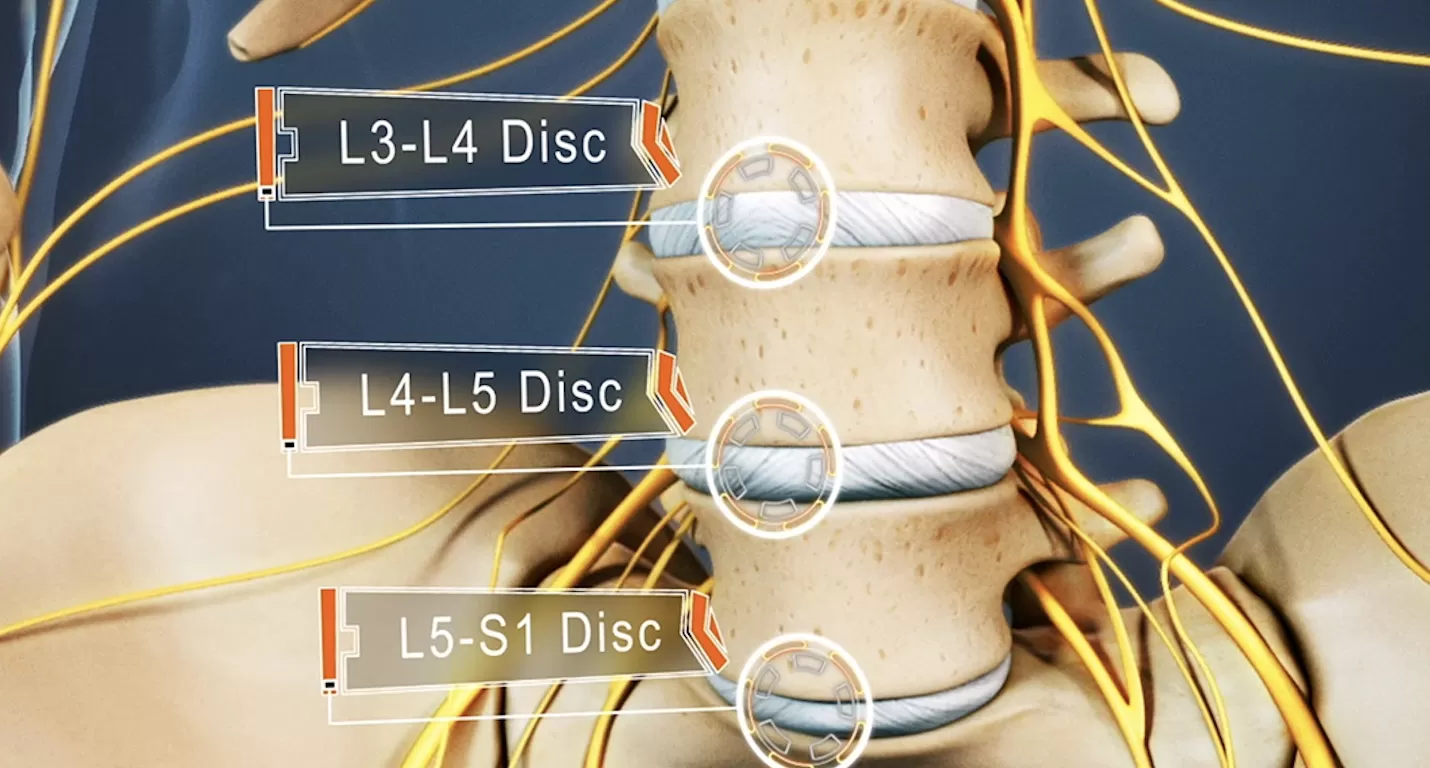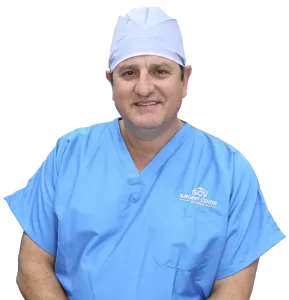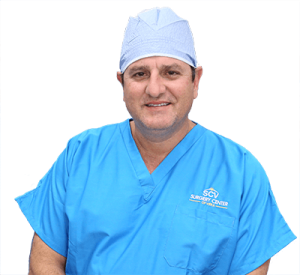Do you ever feel pain in your back that won’t go away? You may have a Lumbar L3-L4 disc herniation. This condition is caused by damage to the discs between your spine’s third and fourth lumbar vertebrae (L3 and L4).
Symptoms of a L3-L4 disc herniation can include pain, numbness, tingling, and weakness in the lower back and legs. In this article, we will discuss the causes of L3-L4 disc herniation, symptoms, and treatment options – both surgical and nonsurgical.
The lumbar spine is made up of five vertebrae numbered L1 to L5. They’re located below the cervical and thoracic sections.

L1 — The topmost section of the lumbar spinal column.
L2 — Contains the end of the spinal cord properly. All vertebrae beyond this point only have the spinal nerves and not the spinal cord.
L3 — The middle vertebra of the lumbar spine
L4 — Second to the last section of the lumbar spinal column
L5 — The final section of the lumbar spine.
The functions of the lumbar spine include:
The lumbar being sprained or strained are the most common forms of back pain. The body can be over-exerted from specific situations such as heavy lifting or traumatic injury.
It can also be affected with age, where the spinal discs are more susceptible to cracks and tears over time. The sprain or strain causes pain in the muscles of the back, which may cause a burning or aching sensation.
Disc herniation in each section can induce specific symptoms that could affect lower back pain.

The L3-L4 segment of the spine supports the body’s weight and allows for a range of motion in the lower back. The L3-L4 motion segment consists of the following structures:
Other characteristics in the L3 and L4 vertebrae include the Lamina, Pedicle, and facet joints (zygapophyseal joints).
Lumbar disc herniation occurs when the disc’s outer wall – the annulus fibrosus – develops traumatic tears (annular tears). This allows the jelly-like nucleus pulposus to push backward out of the tear into the spinal canal or neural foramen.
This is called a herniation. In many cases, this hernia can impinge on a nerve, giving rise to inflammation and irritation of the affected nerve.
Disc herniation is caused by several factors which can affect the joints individually or as a combination. The most prevalent of these factors is wear and tear in the spine.
As humans age, the cartilage that connects the discs in the spine to the corresponding vertebrae members can become lax and lose elasticity. Herniated discs can also be caused by sudden impact and trauma from accidents or falls.
L3-L4 Disc Herniation may cause joint or muscle pain or radicular pain caused by the compression of the nerve roots. The pain or discomfort may be in the form of a dull ache in the lower back or a feeling of stiffness in the back.
The most common symptom of a herniated disc is pain. The pain may be mild or severe and can radiate into the buttocks, thigh, and leg. Other symptoms include:
Several different exercises can help to treat and recover from an L3-L4 disc herniation. These exercises can help strengthen the spine’s muscles, improve flexibility, and reduce pain.
Some of the best exercises for treating an L3-L4 disc herniation include:
Strengthening exercises: Strengthening the spine muscles can help take pressure off the discs and promote healing.
Flexibility exercises: Improving flexibility can help to reduce pain and promote healing.
Pain relief exercises: These exercises can help to release tension and pressure on the discs and nerves, providing relief from pain.
Aerobic exercise: Aerobic exercise can help to improve blood flow and reduce inflammation.
Combining flexibility, strengthening, and aerobic exercises is an effective way to treat a herniated disc. It’s important to start slowly and gradually increasing the pace your body can tolerate. If you experience any pain, stop, rest, and communicate with your doctor.
If nonsurgical methods fail to provide relief from the pain, your doctor may recommend surgery. There are different surgery options available for patients who have been diagnosed with herniated discs.
When considering surgery, it is important to note that surgery usually involves reducing the compression on the nerve and eliminating the pain caused by the herniated disc. Patients should be aware that some surgical options carry more risk of complications than others. These complications could include infection or excessive blood loss and often tend to compromise the integrity of the spine and general patient wellbeing.
The surgical treatment selection typically depends on two factors; the associated symptoms and the severity of the patient’s injury. These options range from minimally invasive surgical procedures to artificial disc replacements or spinal fusion in extreme cases.
Before a procedure is selected, patients are advised to consult a spine expert to conduct a full MRI scan and review and allow for a thorough examination and subsequent localized diagnosis.
The most advanced surgery in the world for a herniated disc is the Deuk Laser Disc Repair.
This revolutionary procedure is Deuk Spine Institute’s specialized alternative to dangerous invasive surgeries like spinal fusion or total disc replacement. The laser disc repair does not weaken or compromise the health and integrity of the spine.
Our modernized approach to laser spine surgery has a 95% success rate with no complications in any patient over 15 years of performing this procedure and over 1,300 patients treated.
Deuk Laser Disc Repair surgery is a form of endoscopic spine surgery performed in our state-of-the-art surgery center under sedation while the patient relaxes. Through a ¼-inch incision, the injured disc is visualized using an endoscope and live imaging via a high-definition camera attached to the spinal endoscope.
With this method, Dr. Deukmedjian carefully eliminates only the injured disc tissue causing pain and discomfort and leaves the rest of the patient’s own natural disc in place to preserve spinal motion and function. Fusions and artificial discs are not necessary because the patient’s repaired natural disc is left in place.
Deuk Laser Disc Repair uses a precision laser to vaporize the herniated tissue and provide the most effective laser spine surgery available. Bone and surrounding tissues are not damaged or removed during this procedure, unlike traditional microdiscectomy, artificial discs, and spinal fusions.
Dr. Ara Deukmedjian uses FDA-approved tools to access the disc through a natural space in the spine where he does not drill through bone as is done with microdiscectomy. Drilling through bone weakens the spine, which leads to future complications that may require fusion surgery.
Once the herniation and annular tear have been gently vaporized, the body can heal naturally. Irritation around the spine decreases, and neurological symptoms from nerve root pressure subside. In time, the disc functions as it did before injury and herniation.
After surgery, patients wake up to immediate relief and a surgical scar so small the surgeon can cover it with a Band-Aid. Only a few drops of blood are lost and no hospitalization is required. All 1,300 Deuk Laser Disc Repair surgeries done to date have been outpatient with a 1-hour recovery.
Lumbar disc conditions can be diagnosed through the following:
At Deuk Spine Institute, we specialize in minimally invasive surgical techniques and comprehensive spine treatments to cure back and neck pain. Our world-class physicians are personally invested in the well-being of every patient.
Start your treatment with us today by submitting your MRI online for a free remote review to determine your candidacy for surgery.

